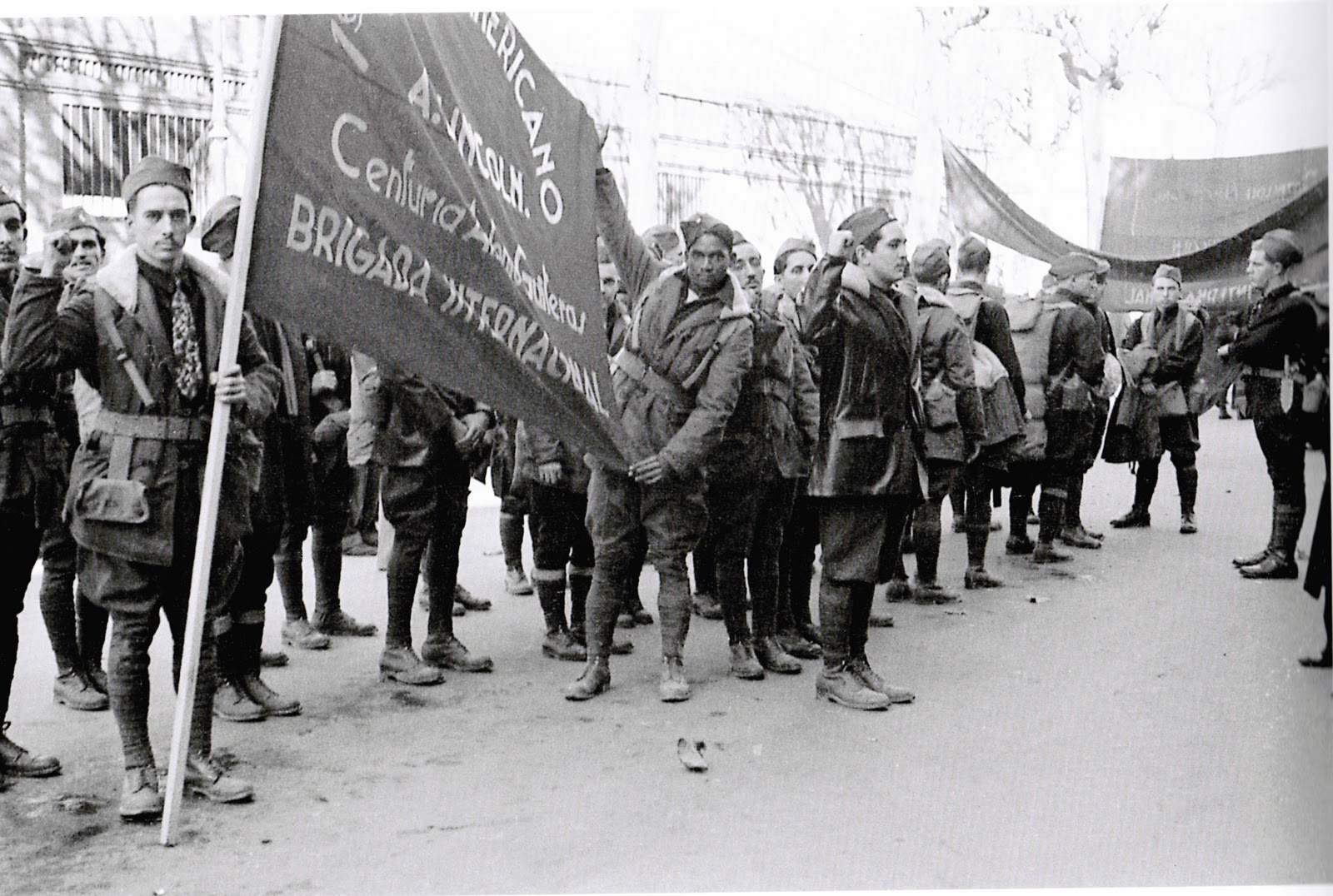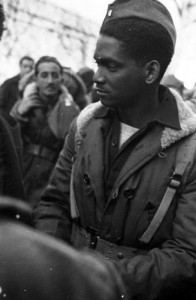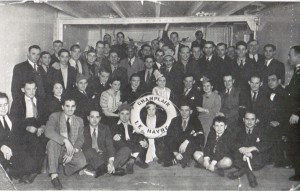Who is the Mysterious “Cuba Hermosa”? New Evidence Comes to Light

Figure 2. Cuban volunteers belonging to the Abraham Lincoln Brigade. Barcelona, January 1937. Photo Agustí Centelles.
In 2009 an anonymous black International Brigades volunteer became famous when his picture garnered the attention of the international news media. The Spanish government wanted to give the photograph of the man, taken in Barcelona in January 1937 by Catalán photojournalist Agustí Centelles, as a gift to newly elected U.S. President Barack Obama in commemoration of the more than 100 African-American volunteers who fought for the Republic. The volunteer’s uniform indicated that he had traveled from the United States, and Centelles’s estate identified him as a member of the Abraham Lincoln Battalion. Everyone assumed the man was African-American.[1]
When the news media picked up the story, a small group of scholars launched a transnational investigation to determine the man’s name and try to notify his family of the honor. An unexpected discovery followed. The man was not African-American, but Cuban. The vital clue was a second photograph (Figure 2) taken at the same time, in which the man holds up a banner reading, in part, “Centuria Antonio Guiteras.” Named for Antonio Guiteras—Cuban anti-imperialist revolutionary activist and political leader killed by Fulgencio Batista’s forces in May 1935—the Centuria was a subunit of the Abraham Lincoln Battalion known in English as “the Cuban Section.”[2]

Fig. 1. Agustí Centelles, International Volunteer (Cuban), Barcelona, January 1937. Spain, Ministry of Culture, Centro Documental de la Memoria Histórica, Archivo Centelles
U.S.-based scholars Sebastiaan Faber and James D. Fernández, both members of ALBA’s executive committee, in consultation with scholars of the Cuban volunteers from other countries, scoured the ALBA archives and other sources for clues about the man’s identity. The memoir of U.S. volunteer John Tisa, Recalling the Good Fight (1985), provided key evidence. The book includes a photograph (Figure 3) of a large group of passengers on the S.S. Champlain voyage to Europe in in January 1937 carrying Tisa and the original members of the Centuria Guiteras.[3] In the photograph an individual appears whom Faber and Fernández determined was both the man in the Centelles photograph and a man Tisa called “Cuba Hermosa” (“Beautiful Cuba”).[4] At the Centro de Documentación de las Brigadas Internacionales in Albacete, I discovered another photograph (Figure 4) from the voyage which includes the same anonymous individual.[5] A third photograph (Figure 5) printed in Tisa’s memoir gives a closer look at his face.[6]
In April 1937 Tisa described him: “Hermosa’s name, Cuba Hermosa, translated, means ‘Beautiful Cuba,’ but his first name is really José. About 5 feet 8 inches, boyish looking, magnificently proportioned, erect, and strong, he is beautifully jet black, with a mouthful of pearls for teeth and black, glistening eyes that are always smiling.”[7] Based on the passenger list for the Champlain’s voyage, Faber and Fernández came up with five possible names for the mysterious man in the photographs, none of which was José: Bienvenido Domínguez, Faustino García, Juan Godoy, Ricardo Pérez, and Ronaldo Rodríguez.[8]
I stayed on the lookout for Cuba Hermosa as I conducted transnational research on Cuban antifascism beginning in 2010. Keeping in mind his jaunty grin, prominent ears, and high cheekbones, I searched photographs for his face. A scrap of paper listing the five possible names traveled with me. As I followed Cuban antifascists across borders and oceans, I sought this famous anonymous man.
The first apparent match occurred close to home. An April 1938 photograph (Figure 6) in ALBA’s Harry Randall Fifteenth International Brigade Photograph Collection shows a man who appears to be a match. The caption identifies the man as Antonio García.[9] Figure 7 shows all five images of the face for comparison.
Was Antonio García the person previously identified on Faber and Fernández’s list as Faustino García? Indeed, the Champlain passenger list gives the name as “Faustineo A. G. y Fernández”[10] and in the ALBA list “Roll Call – American Volunteers in the Spanish Civil War” appears the clearly mangled name “Faustineo Garcia y Frandez A.”[11] Perhaps, then, the man’s full name was Faustino Antonio García y Fernández—but what about Tisa stating his name was José?
![Figure 6 “Antonio Garcia, Auto Park, 59th Battalion Miguel Lausurica [sic], Darmos Apr 1938”. Tamiment Library, NYU, 15th IB Photo Collection.](https://albavolunteer.org/wp-content/uploads/2016/11/Fig-6-Tam-218x300.jpg)
Figure 6 “Antonio Garcia, Auto Park, 59th Battalion Miguel Lausurica [sic], Darmos Apr 1938”. Tamiment Library, NYU, 15th IB Photo Collection, photo 11-0346.
A September 1937 report on Antonio García in the Records of the International Brigades in the Comintern Archives of Moscow reveals a bit more about his identity and experience in Spain. Antonio García was 28 years old, from Havana, and a blacksmith. He arrived in mid-January 1937, which corroborates Tisa’s account of travel on the Champlain, and he worked in “the XV Brigade American Battalion” (the Abraham Lincoln Battalion) as a cook. The report explains a disciplinary incident in which García overstayed a leave in Madrid and then became “afraid to go back to the Brigade for fear of being punished.” He wanted “to rest and then go back to the front,” the report states, and received a warning that a second offense would land him in Spanish court.[14]
Far-flung fragments thus combine to provide a partial sketch of the mysterious Cuba Hermosa, a tiny portrait of the man with the jovial, slightly crooked grin. Brief notations in Cuban sources conclude the portrait on a tragic note. The two major Cuban books on the history of Cuban volunteers for the Spanish Republic include lists of hundreds of known Cuban volunteers, and both list Antonio García as having died after the war.[15] A list of Cubans killed in the war which I found in the Fondo Primer Partido Comunista at the Instituto de Historia de Cuba in Havana, however, gives a different, more specific end to the mysterious figure, listed only by his pseudonym: “Cuba Hermosa, suicide.”[16] Perhaps this discrepancy means that Antonio García is not Cuba Hermosa after all; more probably, however, it indicates the occurrence of one of the endemic errors and concealments present in the transnational archive of the international volunteers in the Spanish Civil War.
The search for Cuba Hermosa illustrates centrally important points about the study of the international volunteers. Interest in the man in the photograph began with motivations that were politicized, sentimental, and turned out to be based on false assumptions. As problematic as they were, however, these motivations set in motion a search by multinational scholars who pieced together bits of information from fragmentary records dispersed around the world. Assumptions shattered, politics and sentiments set aside, we worked to find one man among the thousands of volunteers whose identities and experiences have been largely obscured. If not for the coincidence of events and motivations, Cuba Hermosa would have stayed anonymous, his remains scattered across the transnational archive. Yet vital new information and previously hidden connections relevant to the big picture emerged as we reassembled a partial portrait of just one individual. Many others wait to be discovered.
Ariel Mae Lambe is Assistant Professor of History at the University of Connecticut. Her book in progress studies Cuban antifascism including support for the Republic in the Spanish Civil War.
[1] James D. Fernández and Sebastiaan Faber, “Mystery Photo: Gift to Obama Puts ALBA in the Spotlight,” The Volunteer, New York, 6 March 2010. Accessed online 2 July 2010.
[2] ibid. See also: Ana Suárez Díaz, “La ‘Centuria Guiteras’: De Nueva York al Frente de Jarama (1937),” Caliban: Revista Cubana de Pensamiento e Historia VII (April–June 2010).
[3] John Tisa, Recalling the Good Fight: An Autobiography of the Spanish Civil War (S. Hadley, MA: Bergin and Garvey Publishers, Inc., 1985), 82.
[4] Natalia Junquera, “El brigadista era cubano: El voluntario que aparece en la foto que Zapatero quería regalar a Obama zarpó de Nueva York, pero no nació en EE UU—Aún se ignora su nombre,” El País, Madrid, 1 March 2010. Accessed online 2 July 2010.
[5] “Brigadistas cubanos en el barco francés Le Havre [sic],” No. 240, Centro de Documentación de las Brigadas Internacionales (CEDOBI), Universidad de Castilla-La Mancha, Albacete, Spain. Another similar picture of the same Cubans in a different pose appears in Denise Urcelay-Maragnès, La Leyenda Roja: Los voluntarios Cubanos en la Guerra civil española (León: Lobo Sapiens, 2011), 261.
[6] Tisa, Recalling the Good Fight, 88.
[7] Tisa, diary entry, 17 April 1937, in Recalling the Good Fight, 70.
[8] Junquera, “El brigadista era cubano.”
[9] “Antonio Garcia, Auto Park, 59th Battalion Miguel Lausurica [sic], Darmos Apr 1938,” 11-0346 Photo Unit #: E0427, Harry Randall: Fifteenth International Brigade Photograph Collection ALBA PHOTO 011, Abraham Lincoln Brigade Archive, New York University, New York. Miguel Ángel Lauzurica was a Cuban volunteer. The 59th was another battalion of the XV I.B. with many Cubans.
[10] “Champlain,” 5 January 1937.
[11] Available online at: http://www.nyu.edu/library/bobst/research/tam/alba_names.html. Accessed 31 August 2010.
[12] Untitled list of names, RG 4.11/2005(102–150), Registro General, Instituto de Historia de Cuba (IHC), Havana, Cuba. Strikethrough in original.
[13] José García is listed separately from Antonio García in Alberto Alfonso Bello and Juan Pérez Díaz, Cuba en España: Una gloriosa página de internacionalismo (Havana: Editorial de Ciencias Sociales, 1990), 263; “José García Cubas” is listed separately from Antonio García in Instituto de Historia, Cuba y la defensa de la República Española (1936–1939) (Havana: Editora Política, 1981), 297; “José García Cuba…Marinero…Stgo. Cuba” is listed as a prisoner in “BURGOS: CAMPO DE CONCENTRACION,” Expediente 5/25, Legado Cubano 18, No. 53, Caja 63235, Archivo Histórico Provincial (AHP), Albacete, Spain.
[14] “Rapport No. 1741 – en cause: Garcia Antonio,” 21 September 1937, File 593, Subseries III, Opis 6, Fond 545: Records of the International Brigades, Comintern Archives, Russian Center for the Preservation and Study of Recent History (RGASPI), Moscow, Russia.
[15] Instituto de Historia, Cuba y la defensa, 294; Bello and Pérez Díaz, Cuba en España, 260.
[16] “Relación de los Cubanos muertos en la guerra de liberación e Independencia de España,” undated, Doc. 1/2:1/1.10/45–202, Fondo Primer Partido Comunista, IHC.
















